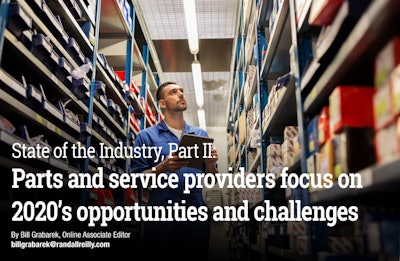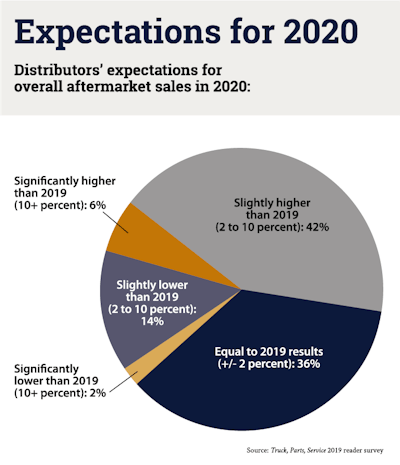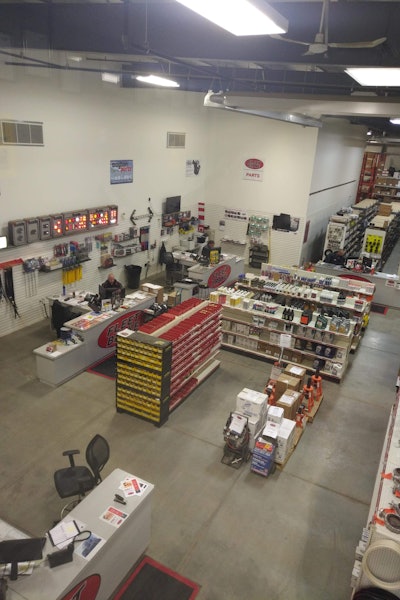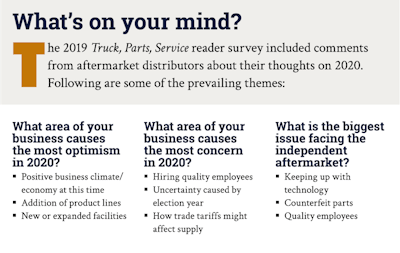
“The biggest driver for the aftermarket is the utilization of vehicles, which drives aftermarket parts requirements, and the manufacturers put a lot of vehicles into the market over the last several years,” John Blodgett, vice president of sales and marketing, MacKay & Company, said during the fourth quarter of last year.
“We’ve had some really strong years and there’s a good number of vehicles that are going to need service and parts, which will help the aftermarket,” Blodgett said.
 Click to enlarge.
Click to enlarge.MacKay & Company, as of the 4th quarter of 2019, was forecasting aftermarket growth of 4.6 percent growth in 2019 over 2018, and a 4.1 percent increase for 2020 over 2019 — both have about 1.5 percent pricing per year growth included.
“It looks like there’s going to be growth, but not huge growth,” he said. “The flipside is, through the first half of the year, we wouldn’t anticipate a recession and we see signs of concern but no confirmation of one in the second half of the year.
Blodgett said the economy is slowing because of trade issues and a soft economy in other parts of the world, which is impacting exports. “We also have the issues with China and the new NAFTA [between the United States, Canada and Mexico] — all of these are certain to have an impact, causing a drop in fleet utilization,” he added.
Although OE production is showing signs of a slowdown, the aftermarket trend looks to be stable for 2020, according to Tina Hubbard, chief operating officer, HDA Truck Pride. “Our industry has always been cyclical, so some degree of aftermarket slowdown in the next two to three years would be typical,” she says.
 DeCarolis Heavy Duty Parts has made investments that will help the company in the near term.
DeCarolis Heavy Duty Parts has made investments that will help the company in the near term.Chris Baer, CEO and President, VIPAR Heavy Duty, says because of some uncertainty within the economy and going into an election year, the political landscape will continue to impact the industry. Additionally, international trade decisions and tariff actions will continue to impact the aftermarket.
“The truck and trailer build along with the used vehicle market will continue to present challenges and opportunities depending on the segment of the market,” Baer says. “With the total number of trucks on the road increasing as well as the average age of vehicles, it is a good time to be in the heavy duty truck parts business.”
DeCarolis Heavy Duty Parts has made investments in the company General Manager Greg Rawleigh says will help the company in the near term.
“We have invested in new DPF cleaning equipment, inventory software and e-commerce capabilities. These improvements will continue to help our growth into 2020,” Rawleigh says.
PBS Truck Parts President Bill Nolan says, “We see a relatively flat year for 2020 based on our late-year results and the overall feeling in the marketplace. It will still be a good year with growth, but not as dynamic as 2017 and 2018.”
Midwest Wheel Companies is projecting 5 percent growth for 2020, but that forecast comes with a couple caveats: the presidential election and tariffs.
 Fleet Brake Parts & Service expects help from fleets that will be more likely repairing older units rather than investing in new ones.
Fleet Brake Parts & Service expects help from fleets that will be more likely repairing older units rather than investing in new ones.“If there is a change in the presidency, it could be a negative for business because … higher taxes become a real possibility, which is going to tighten everybody’s pocketbook a little bit,” says CEO and President Michael Callison. “Also, if the tariffs go away that would give us some positive momentum. They haven’t negatively hurt our business, but it’s hard to make sourcing decisions when you don’t know what’s going to change.”
Andy Robblee, president, Six Robblees’ says margin compression will be an issue in 2020 because of the growing number of customers who are researching and buying online, which means Six Robblees’ is competing on a national level.
“Another issue is cost growth. The inflation growth has been tremendous and we’re not necessarily able to recover that in the market,” Robblee says. Rising input costs, such as the cost of labor in the company’s big city markets are a factor, he adds.
“Our input costs have gone way up but our output isn’t keeping pace, so I think the challenge is how we’re going to work through that margin compression,” Robblee says.
In 2020, Fleet Brake Parts & Service expects help from fleets that will be more likely repairing older units rather than investing in new ones.
“In addition, we see a trend in parcel delivery increasing and the ‘last mile’ business of trucking increasing. We intend to take advantage in this growth sector,” says President John Bzeta.
 Click to enlarge.
Click to enlarge.Despite persistent chatter about an impending recession, Sean Ryan, president and treasurer, says it’s business as usual at Point Spring & Driveshaft Co.
“I’ve been hearing for some time from colleagues in the industry and pundits on TV that a recession and a slowdown is imminent. What I keep telling my team is that we don’t know when the music is actually going to stop, so let’s keep dancing until it does,” Ryan says.
“We control how well we get back to customers with timely and knowledgeable information. We control having quality parts on our shelves at fair prices and delivering it quickly. We control being professionals and respectful. The rest is just noise,” he says.
(Editor’s note: Part III of the TPS State of the Industry report takes a look at how dealerships are adjusting after the brisk sales of the past couple years. It will appear in TPS Daily on Tuesday, Jan. 7.)










